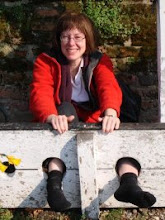Here is a coverlet that I bought recently. It was found on Tyneside by a dealer, at the bottom of a box of textiles. It looks as if either a hexagon top was shared out by cutting it in half, or less likely, someone did not finish a project. You can see that the border design has been cut in half....and then a border of turkey red fabrics added......
The turkey red prints are OK in some areas..but in a few, the overprinted green has perished....must have been a different lot of dye? It is very specific to these areas, as shown in this photo....
Turkey red prints were popular from 1870 to 1890 but continued to be made and used after that....
The Colouring the Nation book states that yellow blue and green indicate a pre 1865 date.....but I'm sure many are later than this..
The hexagons are small but well sewn....no papers, but oddly enough, many of the basting threads are still in place and were not removed...a picot print here and a seaweed or branch pattern, these were popular over a long period, from 1820 to 1900.
This conversation print is seen several times on this coverlet, these were popular from 1875 to 1900. They were popular for shirtings and childrens clothes. The fabric seen here with the horseshoe and whip is a dimity, a ribbed fabric popular for underclothes, childrens clothes and nightwear....it derives from the latin for "two threads".
And here is a half mourning print. Mourning rules were observed during the Victorian era...
The underside shows that the top has faded, colours were originally much brighter!
Careful fussy cutting of the hexagons...more half mourning fabrics....
Another rossette with conversation/dimity fabrics....
More fussy cutting...much attention paid when the top was made....basting threads visible here...
More interesting prints...
Striped fabrics used to good effect..
The reverse of the top, showing the brighter, original colours..
And many of the fabrics are textured, as here. It is hard to date this top, as we know that ragbags often held older fabrics. But the centre of the top is probably 1880 to 1890....this top was definitely used on a bed, which is of interest. It added a lively touch to someones bedroom, and altough the top was undoubtedly special (special enough to merit being divided in half?) it was not put away unused as a "best" quilt.....














Was the green dyed with a single dye or was it blue and yellow overdyed? Interesting piece.
ReplyDeleteI've never seen such a quilt before. It's like it was valuable enough to keep and remake but not fine enough to take out the basting. And the fact that it was actually used is also intriguing. Thanks for sharing.
ReplyDeleteI love this, and your social history associated with it. I'd love to know its history and why it ended up as half a quilt.
ReplyDelete